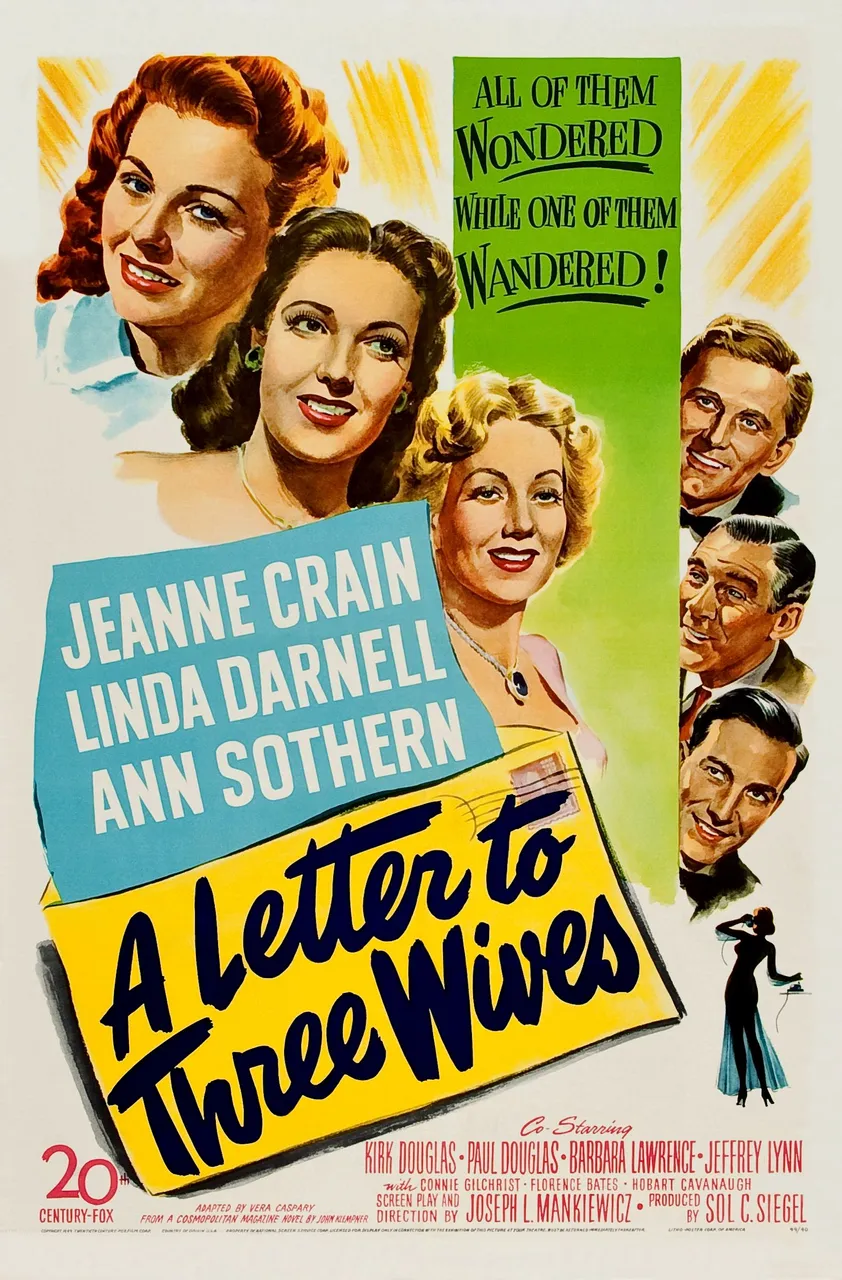
A Letter to Three Wives is a 1949 American romantic comedy-drama film directed by Joseph L. Mankiewicz, based on John Klempner's 1945 novel, "A Letter for Five Wives". The film tells the story of a woman who mails a letter to three women, informing them that she has left town with the husband of one of them, but not saying which one. The film stars Jeanne Crain, Linda Darnell, Ann Sothern, Paul Douglas, Kirk Douglas, and Jeffrey Lynn.
The plot is structured around three flashbacks, each focusing on a significant event in the lives and marriages of the three wives. The wives' husbands are played by Ann Sothern and Kirk Douglas, Linda Darnell and Paul Douglas, and Jeanne Crain and Jeffrey Lynn. The film explores the challenges and conflicts in their marriages, with money being a central theme.
Mankiewicz's writing is described as scintillating and expressive, and his daring direction makes the film burst into life. The film is both emotionally intense and comedic, with a magical ending that adds a metaphysical dimension to its wit. In 1985, 20th Century-Fox Television decided to remake the film, hiring Larry Elikann to direct and Sally Robinson to adapt Mankiewicz's screenplay.
Plot
Here is a brief summary of the plot:
- A small-town seductress, Addie Ross (played by Linda Darnell), sends a letter to her three best friends, informing them that she has run off with one of their husbands. The letter does not reveal which husband she has taken.
- The three wives, Debra (played by Jeanne Crain), Linda (played by Ann Sothern), and Porter (played by Paul Douglas), are informed about Addie's departure and start worrying about their own marriages.
- The film presents flashbacks of each wife's marriage, focusing on a crucial event that might have led to the breakup of their relationships.
- Debra's story involves her husband, Brad (played by Kirk Douglas), and his business partner, Porter (played by Paul Douglas).
- Linda's story revolves around her husband, Loren (played by Jeffrey Lynn), and his infidelities.
- Porter's story features her husband, Ralston (played by Kirk Douglas), and her own personal growth.
Trailer
https://inleo.io/threads/view/taskmaster4450le/re-leothreads-8ivpe9sp
Cast
- Jeanne Crain as Deborah Bishop
- Linda Darnell as Lora Mae Hollingsway
- Ann Sothern as Rita Phipps
- Kirk Douglas as George Phipps
- Paul Douglas as Porter Hollingsway
- Jeffrey Lynn as Brad Bishop
- Thelma Ritter as Sadie (uncredited)
- Celeste Holm as the voice of Addie Ross (uncredited)
The film also features various uncredited roles, including:
- John Davidson as John
- Sayre Dearing as Country Club Member
- Franklyn Farnum as Country Club Member
- Sam Finn as Second Waiter
- James Adamson as Porter's Butler
- Joe Bautista as Thomasino
- Patti Brady as Kathleen
- Ralph Brooks as Bookie Dancer at Country Club
Director: Joseph L. Mankiewicz
Writer: Joseph L. Mankiewicz, Vera Caspary
Box Office Gross: $14,768
Distributor: 20th Century-Fox Television
Genre: Drama
Release Date: June 19, 2002 (France)
Themes
- Infidelity: The film delves into the issue of infidelity in the marriages of the three wives, with their husbands being unfaithful to them.
- Money: Money is a central theme in the film, as the couples' financial situations play a significant role in their relationships and decisions.
- Cultural battles: The film highlights the cultural clashes between the middle class and the elite, as well as the battle between commerce and art.
- Emotional intensity: The film is known for its emotional intensity, with the wives experiencing a range of emotions throughout the story.
Reception
A Letter to Three Wives received positive reviews, with critics praising its scintillating and expressive writing, daring direction, and comedic elements. The film was also noted for its innovative approach to the melodrama genre, shifting the focus from the usual patriarchal perspective to an emphasis on emotions.
Settings
The film is set in a small town, with the three wives receiving the letter informing them about Addie's departure and the subsequent flashbacks showcasing their individual stories. The settings in the flashbacks vary, reflecting the different social classes and lifestyles of the couples:
- Debra and Brad's story takes place in a middle-class neighborhood.
- Linda and Loren's story is set in a luxurious mansion, reflecting their wealthy status.
- Porter's story occurs in a cozy, working-class home.
Visual styles
A Letter to Three Wives features a visually stylish approach, with director Joseph L. Mankiewicz's daring direction making the film stand out. The film's visual style includes:
- Expressive lighting: The film uses lighting to emphasize the emotions and tensions between the characters.
- Camera angles: The film utilizes unique camera angles to create a dynamic and engaging visual experience.
- Cinematography: The film's cinematography is visually appealing, complementing the story and enhancing the overall atmosphere.
Techniques
The film employs several techniques to create an engaging and emotionally resonant experience for the audience:
- Flashbacks: The film uses flashbacks to delve into the individual stories of each wife, providing depth and context to their relationships.
- Direct address: The film features direct address, with some characters speaking directly to the camera, breaking the fourth wall and creating a more intimate connection with the audience.
- Editing: The film's editing technique contributes to its fast-paced and engaging narrative, seamlessly transitioning between the present and the past.
Trivia and fun facts
- The film is based on John Klempner's 1945 novel, "A Letter for Five Wives".
- The film was remade in 1985 by 20th Century-Fox Television, with Larry Elikann directing and Sally Robinson adapting Mankiewicz's screenplay.
- The film is known for its innovative approach to the melodrama genre, shifting the focus from the usual patriarchal perspective to an emphasis on emotions.
- The film's ending is considered magical, adding a metaphysical dimension to its wit.
General:
Page by @iskafan